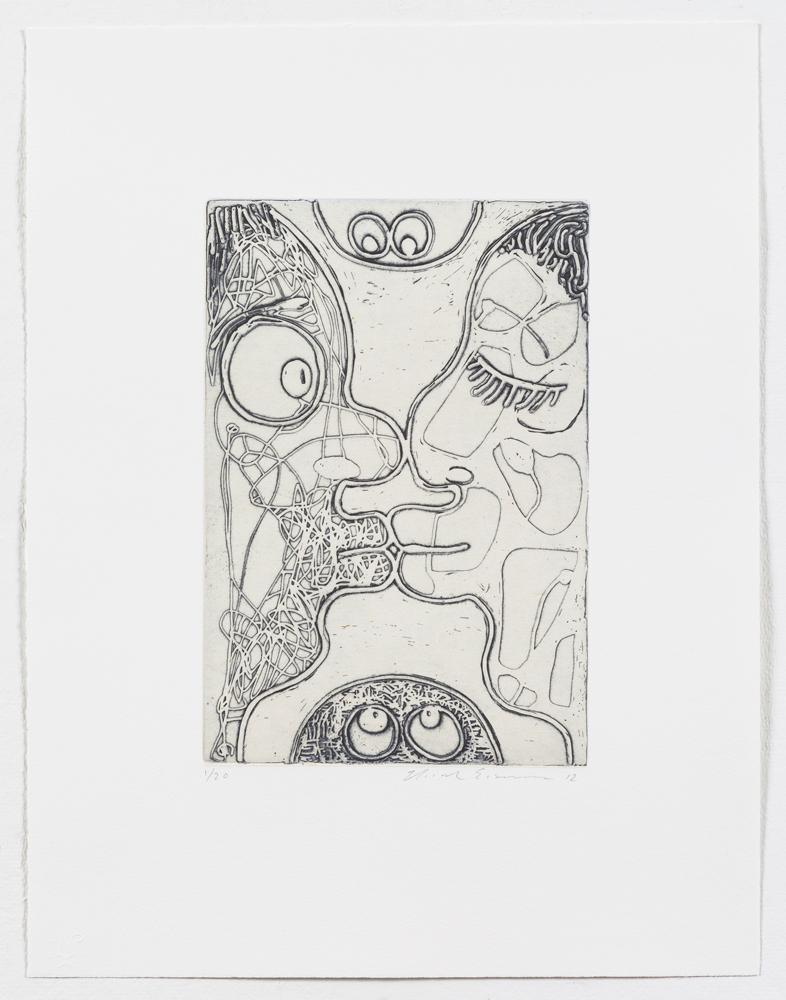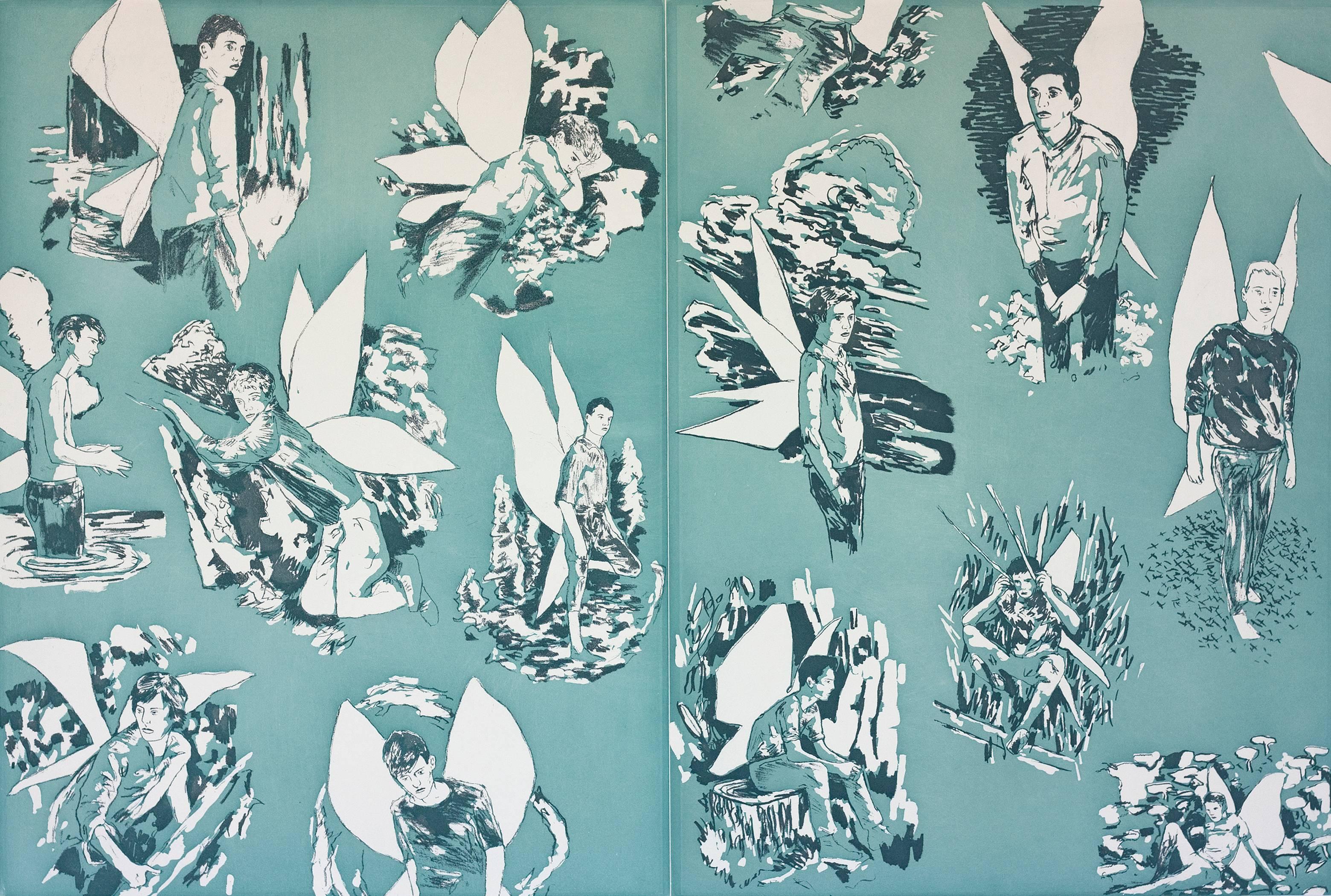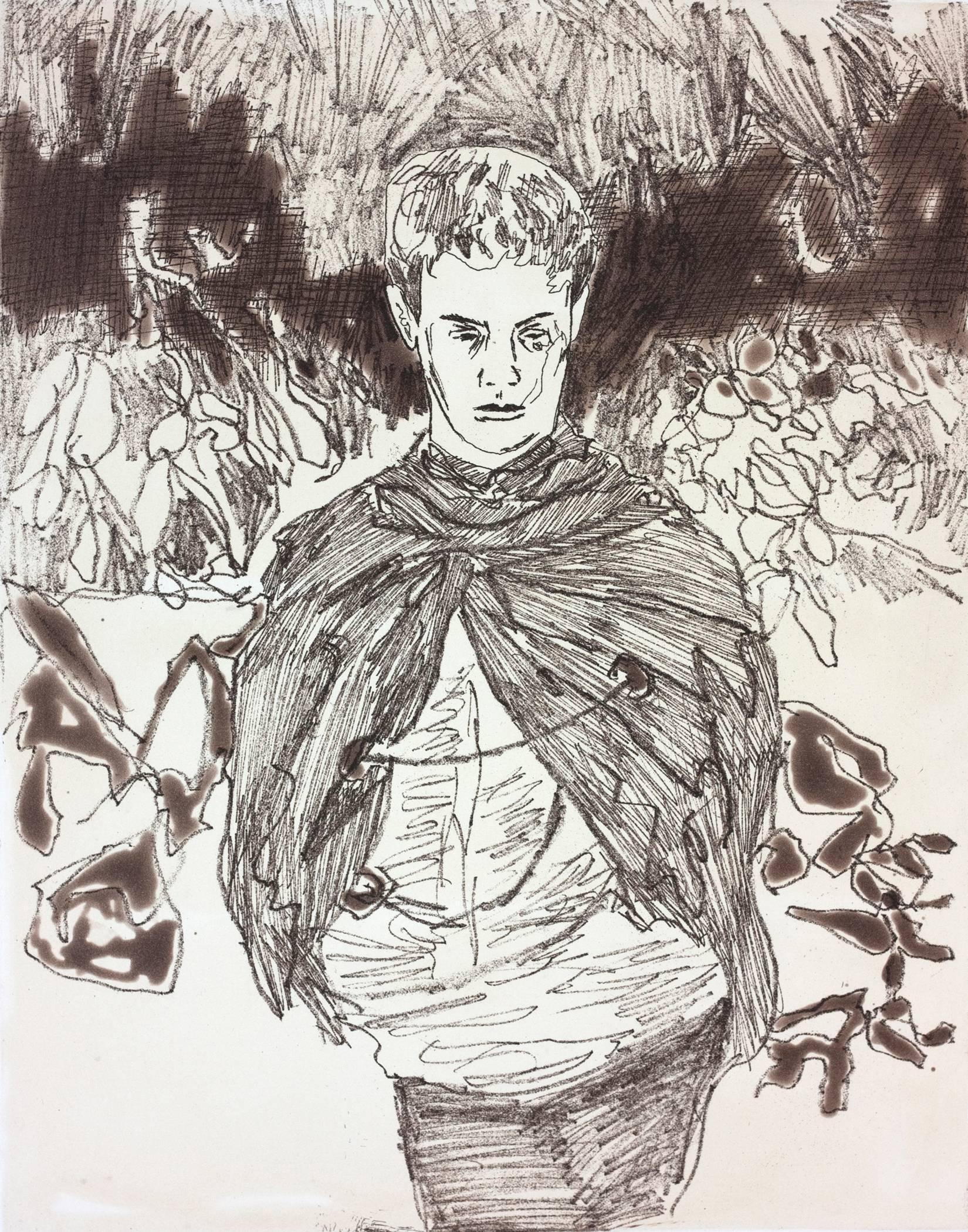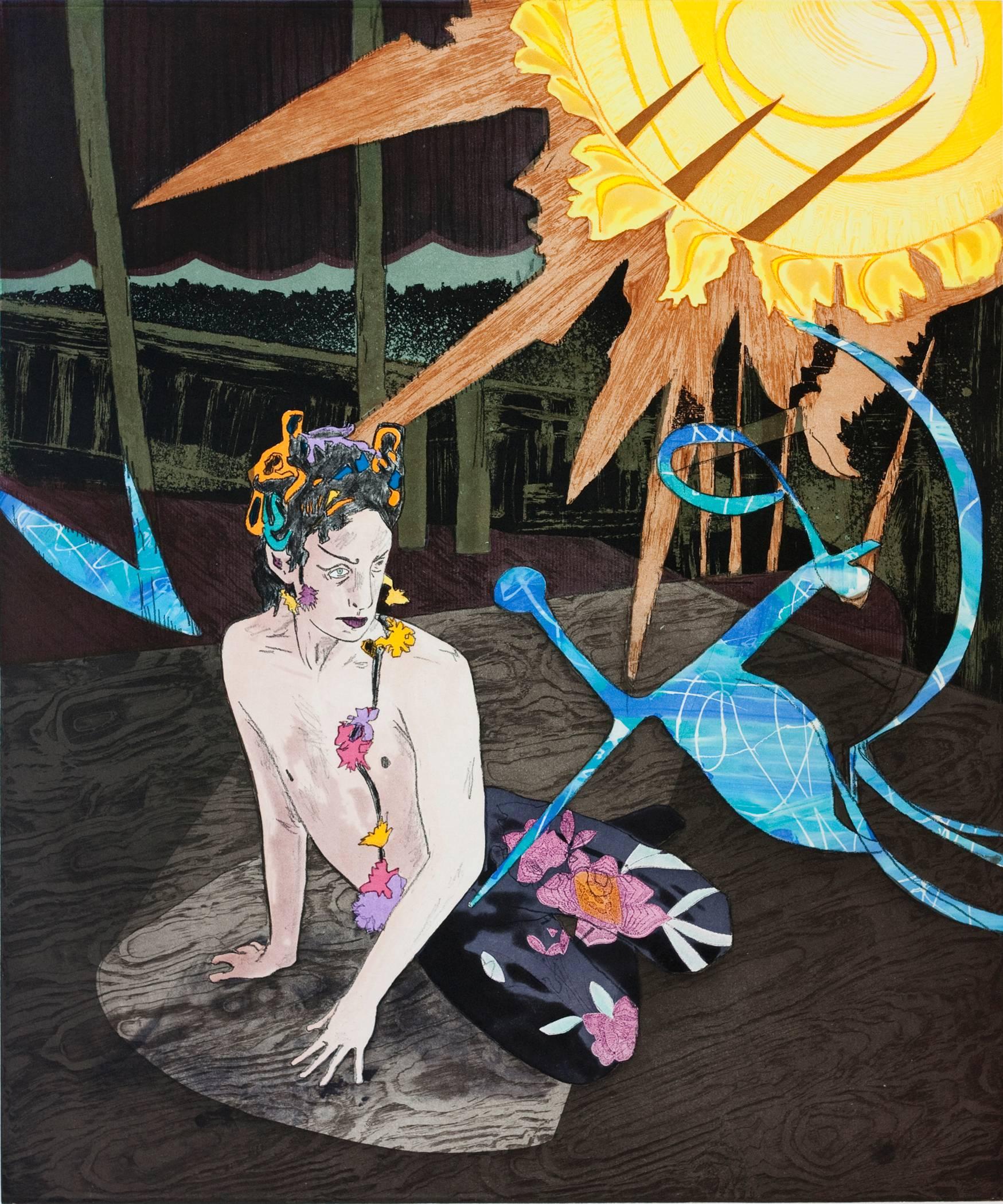Items Similar to 'Mondo Negro III' — African American artist
Want more images or videos?
Request additional images or videos from the seller
1 of 3
Camille Billops'Mondo Negro III' — African American artist2000
2000
About the Item
Camille Billops, 'Mondo Negro III', color etching, 2000, edition 20. Signed, dated, titled, and numbered '7/20' in pencil. A superb, richly-inked impression, on heavy off-white, wove paper, the full margins (3 1/2 to 4 5/8 inches), in excellent condition. Image size 7 7/8 x 7 3/8 inches; sheet size 17 x 14 7/8 inches. Matted to museum standards, unframed.
An impression of this work is in the permanent collection of the US Library of Congress.
ABOUT THE ARTIST
Camille Josephine Billops (1933-2019) was an award-winning African-American visual artist, documentary filmmaker, and art historian. Her etchings are in the US Library of Congress and were included in the renowned exhibition 'Creative Space: Fifty Years of Robert Blackburn's Printmaking Workshop'. Her films have been shown on Public Television and at the Museum of Modern Art; 'Finding Christa' won the Grand Jury Award at Sundance. She and her husband, James Hatch, Professor of English at CCNY, co-founded the Hatch-Billops Archives of Black American Cultural History, a collection of visual materials, oral histories, and thousands of books chronicling black artists in the visual performing arts.
- Creator:Camille Billops (1933 - 2019)
- Creation Year:2000
- Dimensions:Height: 7.88 in (20.02 cm)Width: 7.38 in (18.75 cm)
- Medium:
- Movement & Style:
- Period:
- Condition:
- Gallery Location:Myrtle Beach, SC
- Reference Number:
About the Seller
5.0
Recognized Seller
These prestigious sellers are industry leaders and represent the highest echelon for item quality and design.
Platinum Seller
These expertly vetted sellers are 1stDibs' most experienced sellers and are rated highest by our customers.
Established in 1995
1stDibs seller since 2016
254 sales on 1stDibs
Typical response time: 2 hours
Associations
International Fine Print Dealers Association
- ShippingRetrieving quote...Ships From: Myrtle Beach, SC
- Return PolicyA return for this item may be initiated within 7 days of delivery.
More From This SellerView All
- 'Cargo Carriers' — 1930s New York HarborBy Otto KuhlerLocated in Myrtle Beach, SCOtto Kuhler, 'Cargo Carriers', etching and drypoint, c. 1932, edition 10, Kennedy 44. Signed in pencil. A superb, atmospheric impression with rich burr and selectively wiped overall plate tone, in dark brown ink, on Arches cream laid paper; wide margins (2 to 2 3/4 inches), in very good condition. Printed by the artist. Original Kennedy Galleries mat and label. Scarce. "On my trips up and down N.Y. harbor on the Weehawken Ferry, the late evening sun playing on the side of the big liners has always intrigued me... The liner shown I believe to be the Vaterland of the North German Lloyd...Category
1930s American Modern Figurative Prints
MaterialsEtching, Drypoint
- 'Fantasia Americana - 1880' — Mid-Century American SurrealismBy Lawrence KupfermanLocated in Myrtle Beach, SCLawrence Kupferman, 'Fantasia Americana – 1880', drypoint etching with sandground, 1943. Signed, titled, and annotated 'Series A, 1971 2/6' in pencil. A superb, richly-inked impression, on heavy, cream wove paper, with full margins (2 1/2 to 3 1/2 inches); the paper slightly lightened within the original mat opening, otherwise in excellent condition. One of only 6 impressions printed in 1971, with the added sandground grey background tint. Image size 11 13/16 x 14 3/4 inches; sheet size 18 x 20 1/4 inches. Archivally matted to museum standards, unframed. Collections: National Gallery of Art, Zimmerli Art Museum (Rutgers University). ABOUT THE ARTIST Lawrence Kupferman (1909 - 1982) was born in the Dorchester neighborhood of Boston and grew up in a working-class family. He attended the Boston Latin School and participated in the high school art program at the Museum of Fine Arts, Boston. In the late 1920s, he studied drawing under Philip Leslie Hale at the Museum School—an experience he called 'stultifying and repressive'. In 1932 he transferred to the Massachusetts College of Art, where he first met his wife, the artist Ruth Cobb. He returned briefly to the Museum School in 1946 to study with the influential expressionist German-American painter Karl Zerbe. Kupferman held various jobs while pursuing his artistic career, including two years as a security guard at the Museum of Fine Arts, Boston. During the 1930s he worked as a drypoint etcher for the Federal Art Project, creating architectural drawings in a formally realistic style—these works are held in the collections of the Fogg Museum and the Smithsonian American Art Museum. In the 1940s he began incorporating more expressionistic forms into his paintings as he became progressively more concerned with abstraction. In 1946 he began spending summers in Provincetown, Massachusetts, where he met and was influenced by Mark Rothko, Hans Hofmann, Jackson Pollock, and other abstract painters. At about the same time he began exhibiting his work at the Boris Mirski Gallery in Boston. In 1948, Kupferman was at the center of a controversy involving hundreds of Boston-area artists. In February of that year, the Boston Institute of Modern Art issued a manifesto titled 'Modern Art and the American Public' decrying 'the excesses of modern art,' and announced that it was changing its name to the Institute of Contemporary Art (ICA). The poorly conceived statement, intended to distinguish Boston's art scene from that of New York, was widely perceived as an attack on modernism. In protest, Boston artists such as Karl Zerbe, Jack Levine, and David Aronson formed the 'Modern Artists Group' and organized a mass meeting. On March 21, 300 artists, students, and other supporters met at the Old South Meeting House and demanded that the ICA retract its statement. Kupferman chaired the meeting and read this statement to the press: “The recent manifesto of the Institute is a fatuous declaration which misinforms and misleads the public concerning the integrity and intention of the modern artist. By arrogating to itself the privilege of telling the artists what art should be, the Institute runs counter to the original purposes of this organization whose function was to encourage and to assimilate contemporary innovation.” The other speakers were Karl Knaths...Category
1940s Surrealist Figurative Prints
MaterialsDrypoint, Etching
- 'Food Not Cannon' — rare WPA modernist work of Social ConscienceBy Leon BibelLocated in Myrtle Beach, SCLeon Bibel, 'Food Not Cannon', etching, 1937, edition 12 (an early state, probably unique). Signed in pencil. A fine impression, on cream wove paper, with full margins (7/8 to 2 1/8 ...Category
1930s American Modern Figurative Prints
MaterialsEtching
- 'Foul Rope (Left)' — early American rodeoBy William Robinson LeighLocated in Myrtle Beach, SCWilliam Robinson Leigh, 'Foul Rope (Left)', etching, c. 1920, edition unknown but small. Signed in pencil. Signed in the plate, lower left. A superb, richly-inked impression, in dark brown ink, on buff wove Umbria paper, the full sheet with margins (1 1/2 to 2 3/4 inches); slight toning at the sheet edges, otherwise in excellent condition. Very scarce. Image size 14 7/8 x 11 15/16 inches (378 x 303 mm); sheet size 20 3/8 x 15 3/8 inches (518 x 391 mm). Archivally matted to museum standards, unframed. ABOUT THE ARTIST Born near Falling Waters, West Virginia on a plantation a year after the Civil War, and raised in Baltimore, William Robinson Leigh (1866 - 1955) became one of the foremost painters of the American West. His career spanning some seventy-five years, Leigh created some of the most iconic depictions of the western landscape, admirers referring to him as ‘The Sagebrush Rembrandt’. The son of impoverished Southern aristocrats, Leigh took his first art training at age 14 from Hugh Newell at the Maryland Institute where he was regarded as the best student in his class. From 1883 to 1895, he studied in Europe, mainly at the Royal Academy in Munich with Ludwig Loefftz. From 1891 to 1896, he painted six cycloramas or murals in the round, a giant German panorama. In 1896, Leigh began working as a magazine illustrator in New York City for Scribner's and Collier's Weekly Magazine, and he also painted portraits, landscapes, and genre scenes. Leigh's trips to the Southwest began in 1906 when he made an agreement with William Simpson, Santa Fe Railway advertising manager, to paint the Grand Canyon in exchange for free transportation West. In 1907, he completed his Grand Canyon painting, which led to more commissions and an extensive painting trip through Arizona and New Mexico. These travels inspired him to paint western subjects for the next 50 years, his primary interest being the Hopi and Navajo Indians. In 1910, he traveled to Wyoming, where he painted in Yellowstone Park and created sketches, many of which he later converted into large canvases such as ‘Lower Falls of the Yellowstone’ (1915) and ‘Grand Canyon of the Yellowstone’ (1911). In 1926 he traveled to Africa at the invitation of Carl Akeley for the American Museum of Natural History, and from this experience wrote and illustrated 'Frontiers of Enchantment: An Artist's Adventures in Africa'. In 1933, he wrote and illustrated 'The Western Pony'. His adventures were chronicled in a number of popular magazines including Life, the Saturday Evening Post, and Colliers. For many years, his work was handled exclusively in New York by Grand Central Art Galleries at the Biltmore Hotel. In 1953 Leigh was elected into the National Academy of Design as an Associate member, becoming a full Academician in 1955. In March 1999, the Historical Center of Cody, Wyoming, held an exhibition of his field sketches and finished works depicting his experiences near Cody in the early part of the century. These years, between 1910 and 1921, when he often painted in the Carter Mountain vicinity, were considered pivotal to his artistic development and his devotion to the western landscape. Leigh's work is held in many museum collections of American western art...Category
1920s Realist Animal Prints
MaterialsEtching
- 'Le Paradis Terrestre' (Paradise on Earth) — 1930s SymbolismBy Edouard GoergLocated in Myrtle Beach, SCEdouard Goerg, 'Le Paradis Terrestre' (Paradise on Earth), etching, 1931, edition 40. Signed, titled, and numbered '3/40' in pencil. A fine richly-inked impression, on heavy, cream w...Category
1930s Symbolist Figurative Prints
MaterialsEtching
- Racamadour (French Church Series #10)By John Taylor ArmsLocated in Myrtle Beach, SC'Rocamadour' (French Church Series # 10), etching, 1927, edition 50, Fletcher 186. Signed, dated, and annotated 'First State' in pencil. Titled and dated 'Rocamadour 1926' in the plate, bottom right. A superb, finely detailed impression, in dark brown ink, on buff laid Japan paper, with full margins (1 to 1 7/8 inches), in excellent condition. Image size 13 3/4 x 10 inches (349 x 254 mm); sheet size 15 3/4 x 13 5/8 inches (400 x 346 mm). Matted to museum standards, unframed. Literature: illustrated in Dorothy Noyes Arms, 'Churches of France', The Macmillan Company, 1929. Impressions of this work are in the permanent collections of the Blanton Museum of Art, Chrysler Museum of Art, Cleveland Museum of Art, Davis Museum (Wellesley), McNay Art Museum, Metropolitan Museum of Art, Rhode Island School of Design Museum, and the Whitney Museum of Art. ABOUT THE SUBJECT Rocamadour is a small clifftop village in south-central France. It is known for the Cité Réligieuse complex of religious buildings, accessed via the Grand Escalier staircase. It includes the Chapelle Notre-Dame, with its Black Madonna statue, and the Romanesque-Gothic Basilica of St-Sauveur. ABOUT THE ARTIST “John Taylor Arms will live on and on and future generations centuries from now will marvel at his work... . As a friend and as a man, he fully matched his superb work.” —John Winkler, printmaker Born in Washington, D.C. in 1887, John Taylor Arms attended the Lawrenceville School and began the study of law at Princeton University. In 1907, he transferred to the Massachusetts Institute of Technology and took up the study of architecture. Arms evolved his unique drafting style, with its highly realistic, precise detail and exquisitely rendered effects of light, from his experience and practice as an architectural student. He graduated in 1911 and completed a master’s degree the following year. He then worked as a draftsman with the well-known Carrere and Hastings Company in New York. In 1913 Arms was given a hobbyist’s etching set, and he began to dabble with copperplate and acid. In 1915, after copying a handful of prints by Jongkind and other Etching Revivalists, Arms created his first original etching. His early experiments were picturesque views of European villages, reflecting the influence of Whistler. He inked and printed several of these plates in color in the manner of Charles Mielatz...Category
1920s American Realist Figurative Prints
MaterialsEtching
You May Also Like
- FourpackLocated in Brooklyn, NYFourpack, 2010 Etching with chine colle´ 16 3/4 × 12 7/8 in 42.5 × 32.7 cmCategory
2010s Contemporary Figurative Prints
MaterialsEtching
- Landscape with Adam and Eve with an angelLocated in Llanbrynmair, GB’Landscape with Adam and Eve with an angel’ By Arthur Boyd Medium - Etching with colour on wove. Signed - Yes Edition - Artist Proof Size - 640mm x 820mm Date - 1986 Condition - 8 Colour of print may not be accurate when viewed on a monitor. Arthur Merric Bloomfield Boyd AC OBE (24 July 1920 – 24 April 1999) was a leading Australian painter...Category
1980s Contemporary Figurative Prints
MaterialsEtching
- Revised Endpapers for "The Homosexual Neurosis" (Blue)By Hernan BasLocated in Berkeley, CAColor aquatint. Edition of 35Category
21st Century and Contemporary Contemporary Figurative Prints
MaterialsEtching
- Revised Endpapers for "The Homosexual Neurosis" (Pink)By Hernan BasLocated in Berkeley, CAColor aquatint.Category
21st Century and Contemporary Contemporary Figurative Prints
MaterialsEtching
- The Renaissance ManBy Hernan BasLocated in Berkeley, CAColor softground etching, drypoint and spitbite aquatint.Category
21st Century and Contemporary Contemporary Figurative Prints
MaterialsEtching
- Comus In a Drunken StuporBy Hernan BasLocated in Berkeley, CAColor softground and flatbite etching, spitbite and soapground aquatints, and unique inking.Category
21st Century and Contemporary Contemporary Figurative Prints
MaterialsEtching
Recently Viewed
View AllMore Ways To Browse
Hatcher Collection
Mondo Collection
Camille Billops
Retro New York Travel Poster
Poster Liberty
Jewelry By Salvador Dali
Vintage Hair Flowers
War And Peace Lithograph
Nude Boy
Museum Poster Picasso
Colony Glasses
Wedding Russia
Heart Vintage Illustration
Boy Nude
French Provence Plates
Vintage Art Supplies
Vintage Car Drawing
Art Portrait Painting Clown





